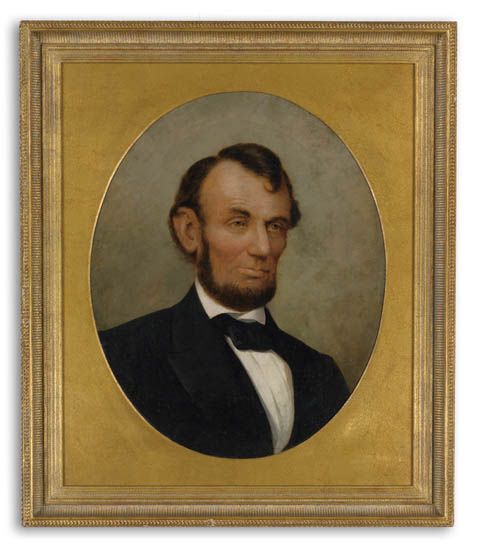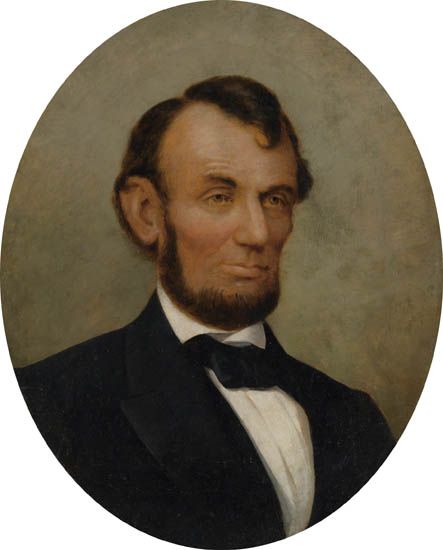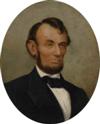Sale 2268 - Lot 76
Unsold
Estimate: $ 60,000 - $ 90,000
DAVID BUSTILL BOWSER (1820 - 1900)
Abraham Lincoln.
Oil on paper photo, laid down on honeycomb paper, mounted on canvas, 1865. 710x560 mm; 28x22 inches (oval). Inscribed "Original Photo in Oil by D. B. Bowser, July 3, 1865" in oil on verso.
Provenance: Robert Purvis, President of the Underground Railroad; Phil Chmielewski, Fox Chase, PA; purchased by the current owner at Butterfield's, San Francisco, March 21, 1990 (the only auction record found for Bowser); private collection.
Exhibited: Of Color, Humanitas and Statehood: The Black Experience in Pennsylvania over Three Centuries, 1681-1891, Afro-American Historical and Cultural Museum, Philadelphia, 1981.
This painting was famously found in a barn near Byberry, PA, a stop on the Underground Railroad and close to the Purvis family. According to a 1981 Philadelphia Inquirer article, From Barn To Museum 'Lost' Portrait Stars in Black Exhibit, Mr. Chmielewski found the painting in a barn in 1944 on farm land his parents bought from the Purvis family. He had stored it in his attic, where the painting was forgotten until a month before the 300th anniversary exhibition celebrating African Americans in Pennsylvania. Chmielewski presented it to the director of the Philadelphia exhibition, Charles L. Blockson, who added the portrait to the display.
Robert Purvis (1810 - 1898) was a leading African-American figure in the Abolitionist movement, and the only African American to lead a major abolitionist organization. The Philadelphian was the son of a wealthy white cotton merchant and a free African-American woman who attended Amherst College. He was the president of the Pennsylvania Anti-Slavery society and a member of Boston's William Lloyd Garrison American Anti-Slavery Society. He welcomed the outbreak of the Civil War and urged Lincoln to pursue emancipation. Purvis was also asked to head the Freedmen's Bureau at the end of the Civil War.
David Bustill Bowser made a career as a portrait painter of some of the leading figures of the day, and, according to Theresa Leininger-Miller, was "one of the most commercially successful African-American artists in Philadelphia in the 19th century." He was the cousin and student of the artist Robert M. Douglass, Jr. of Philadelphia, one of the earliest Philadelphia African-American artists. While the Bowser family is known from the 18th-century teacher Cyrus Bustill to the 20th-century actor Paul Robeson, there remains little information about the artist's early life. Bowser's surviving paintings tell a story of his wide-ranging career, from the early commission of maritime and landscape paintings to the emblems and banners for Philadelphia fireman companies and fraternal organizations.
Leininger-Miller describes how Bowser was commssioned to paint 21 "oil paintings and retouched photographs" of Abraham Lincoln in various poses by both prominent African Americans like Purvis and whites like U.S. Treasury Secretary Jay Cooke. Porter notes how it was long believed that Lincoln himself had commissioned one, and that the Bowser family never cashed his treasured check. We have located two other examples of similar Lincoln busts from 1865--one in the Civil War Museum of Philadelphia and another in a private collection. The Philadelphia exhibition also included a 1858 Bowser portrait of John Brown from the collection of the Philadelphia Historical Society; the artist had hosted Brown at his home.
St. James/Leininger-Miller p. 66; Philadelphia Inquirer p. K01; Porter p. 20 and pp. 30-31.
Abraham Lincoln.
Oil on paper photo, laid down on honeycomb paper, mounted on canvas, 1865. 710x560 mm; 28x22 inches (oval). Inscribed "Original Photo in Oil by D. B. Bowser, July 3, 1865" in oil on verso.
Provenance: Robert Purvis, President of the Underground Railroad; Phil Chmielewski, Fox Chase, PA; purchased by the current owner at Butterfield's, San Francisco, March 21, 1990 (the only auction record found for Bowser); private collection.
Exhibited: Of Color, Humanitas and Statehood: The Black Experience in Pennsylvania over Three Centuries, 1681-1891, Afro-American Historical and Cultural Museum, Philadelphia, 1981.
This painting was famously found in a barn near Byberry, PA, a stop on the Underground Railroad and close to the Purvis family. According to a 1981 Philadelphia Inquirer article, From Barn To Museum 'Lost' Portrait Stars in Black Exhibit, Mr. Chmielewski found the painting in a barn in 1944 on farm land his parents bought from the Purvis family. He had stored it in his attic, where the painting was forgotten until a month before the 300th anniversary exhibition celebrating African Americans in Pennsylvania. Chmielewski presented it to the director of the Philadelphia exhibition, Charles L. Blockson, who added the portrait to the display.
Robert Purvis (1810 - 1898) was a leading African-American figure in the Abolitionist movement, and the only African American to lead a major abolitionist organization. The Philadelphian was the son of a wealthy white cotton merchant and a free African-American woman who attended Amherst College. He was the president of the Pennsylvania Anti-Slavery society and a member of Boston's William Lloyd Garrison American Anti-Slavery Society. He welcomed the outbreak of the Civil War and urged Lincoln to pursue emancipation. Purvis was also asked to head the Freedmen's Bureau at the end of the Civil War.
David Bustill Bowser made a career as a portrait painter of some of the leading figures of the day, and, according to Theresa Leininger-Miller, was "one of the most commercially successful African-American artists in Philadelphia in the 19th century." He was the cousin and student of the artist Robert M. Douglass, Jr. of Philadelphia, one of the earliest Philadelphia African-American artists. While the Bowser family is known from the 18th-century teacher Cyrus Bustill to the 20th-century actor Paul Robeson, there remains little information about the artist's early life. Bowser's surviving paintings tell a story of his wide-ranging career, from the early commission of maritime and landscape paintings to the emblems and banners for Philadelphia fireman companies and fraternal organizations.
Leininger-Miller describes how Bowser was commssioned to paint 21 "oil paintings and retouched photographs" of Abraham Lincoln in various poses by both prominent African Americans like Purvis and whites like U.S. Treasury Secretary Jay Cooke. Porter notes how it was long believed that Lincoln himself had commissioned one, and that the Bowser family never cashed his treasured check. We have located two other examples of similar Lincoln busts from 1865--one in the Civil War Museum of Philadelphia and another in a private collection. The Philadelphia exhibition also included a 1858 Bowser portrait of John Brown from the collection of the Philadelphia Historical Society; the artist had hosted Brown at his home.
St. James/Leininger-Miller p. 66; Philadelphia Inquirer p. K01; Porter p. 20 and pp. 30-31.
Exhibition Hours
Exhibition Hours
Aliquam vulputate ornare congue. Vestibulum maximus, libero in placerat faucibus, risus nisl molestie massa, ut maximus metus lectus vel lorem.






